
Engraving of George Taylor
George Taylor (fl. 1734–1750) was an English boxer also known by the nickname George the Barber.[1] His mentor was James Figg, whose boxing booth Taylor had fought in since 1719.[2] Taylor took over Figg's "Great Booth" in Tottenham Court Road after Figg's death in 1734.[3] One of the main attractions at Taylor's establishment was Jack Broughton, the leading boxer of the era, but Taylor and Broughton soon fell out and the latter opened his own ring.[3]
Like Figg, Taylor is remembered primarily because of his relationship with the painter William Hogarth, who admired boxers and used them as models.[4] Hogarth created an elaborate design for Taylor's gravestone, featuring the boxer pummeling death himself.[4]
References
- ↑ Godfrey, John (1747). A Treatise Upon the Useful Science of Defense (PDF). London: T. Gardner. pp. 61–62.
- ↑ Riding, Jacqueline (2021). Hogarth: Life in Progress. Profile. p. 372. ISBN 978-1-78283-611-7.
- 1 2 Birley, Derek (1993). Sport and the Making of Britain. Manchester: New York. pp. 118–119. ISBN 9780719037597.
- 1 2 Einberg, Elizabeth (2004). "Milton, St John, and the importance of 'Bottom': Another look at Hogarth's "March of the Guards to Finchley"". The British Art Journal. 5 (3): 27–34. ISSN 1467-2006.
External links
This article is issued from Wikipedia. The text is licensed under Creative Commons - Attribution - Sharealike. Additional terms may apply for the media files.